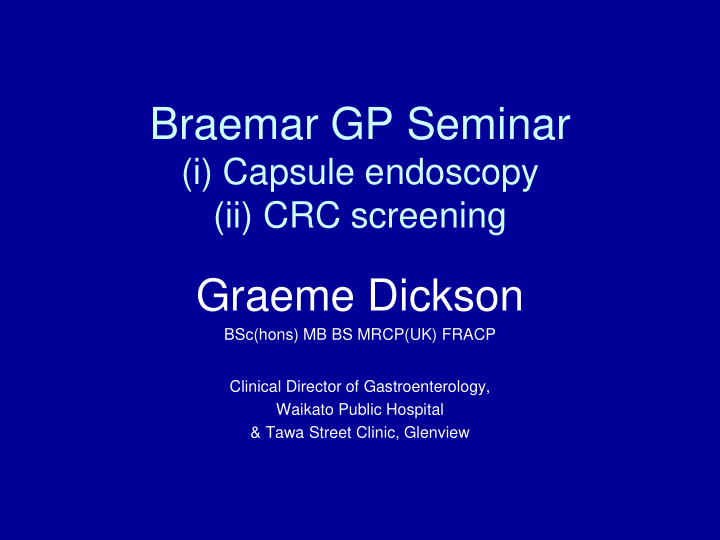



Braemar GP Seminar (i) Capsule endoscopy (ii) CRC screening Graeme Dickson BSc(hons) MB BS MRCP(UK) FRACP Clinical Director of Gastroenterology, Waikato Public Hospital & Tawa Street Clinic, Glenview
Wireless Capsule Endoscopy • Procedure • Indications – Obscure bleeding – Crohn’s – Small bowel polyps • Contraindications • Complications • Outcomes
Capsule endoscopy M2A capsule (11mm x 26mm, 3.7gm) 1. Optical dome 2. Lens holder 3. Lens 4. Illuminating LEDs 5. Imager 6. Battery 7. Transmitter 8. Antenna
Viewing • 60,000 images
Obscure Bleeding - normal UGI & Colonoscopy - historical approach • Enteroscopy • Surgical enteroscopy • access to only10-20% of small • gold standard bowel (4-5m long) • 70-100% sensitivity • 38-75% detection rate • small risk of complications • but morbidity/mortality/cost • but therapeutic options • last resort • Small bowel X-ray • uncomfortable • sensitivity 5% • Red Cell Scan • sensitivity 30-86% • requires 150ml bleeding/24hrs • approximate site • Angiography • 750ml/24hours • therapeutic option
Capsule for obscure GI bleeding polyp tumour other 3% 1% 1% blood no lesion 6% 38% ulceration 15% vascular 36% Pennazio
Angiodysplasia
Obscure bleeding • Age 77 • Warfarin • Prosthetic valve
Crohn’s disease
Peutz Jeghers 6 polypectomies • Aged 18 & 26
Contraindications Complications 1.Dysphagia • Capsule retention 2.Small bowel • 2% obstruction • RFs – NSAIDs – Crohns – Radiation • Patency capsule
Outcomes • Positive studies – Obscure bleeding • High yield if performed early (<1mth) • Allows Rx of lesions found which reduces further bleeding • Negative studies – Obscure bleeding • 80% have no further bleeding at 1 yr • 95% have no major pathology found • Therefore, no further Ixs needed
Availability Public Private • 30 capsules per year • Reimbursed by insurers • Obscure GI bleeding • Costs – recurrent – Capsule: $3578 • Crohn’s – Capsule with patency • Polyposis syndromes study: $4247
CRC screening
CRC in NZ
Stage affects survival
CRC screening • CRC prevention – Colonoscopy – CT colonography – Flexible sigmoidoscopy • CRC detection – Faecal occult bloods (FIT)
Colonoscopy
Colonoscopy – the problems 1. Interval (missed) cancers 2. Complications – Perforation (1/1000) 3. Patient preference – Uncomfortable, requires sedation
Interval cancers CRC between planned colonoscopies • Tandem colonoscopies show 22% adenoma miss rate • 2 to 6% miss rate for CRC • Rt side colon • Flat lesions
Interval cancers – bowel prep
Interval cancers – flat polyps
Interval cancers - technique “…You see but you do not observe…” 1. Caecal intubation rate 2. Withdrawal time 3. Adenoma detection rate
Screening colonoscopy – not for trainees Risk factors for interval cancer 1)Biology – flat, rt sided 2)Poor bowel prep 3)Poor technique 4)Non-Gastroenterologist
CT colonography
CT colonography
Flexible Sigmoidoscopy
Faecal Immunochemical Test (FIT)
CRC screening – what do you choose?
CRC screening – what do you choose? • Colonoscopy -10 yrly from age 50 – Quality (prep; technique; operator) • CT Colonography – 5yrly • Flex Sig – 5 yrly • FIT – 2yrly
CRC screening in NZ – Family History PUBLIC Depends on DHB • Waikato • NZGG moderate/high
Familial Colorectal Cancer • What is their risk of developing CRC? – Average risk at 75yrs=5% – 1 FDR risk=10% (slightly increased) – 1 FDR<55 or 2 FDRs risk=25% (moderate) – 1 FDR<55 & another FDR/SDR (high) OR 1 FDR & 2 SDRs (high) OR HNPCC/FAP/MSI on tumour histology • Can you refer them for a colonoscopy at WPH? – High=yes – Moderate=yes – Low=not resourced www.nzgg.org.nz
CRC screening in NZ – Family History PUBLIC PRIVATE Depends on DHB Depends on Insurer • Waikato • Southern Cross – 1 FDR • NZGG moderate/high • Sovereign/Tower – No cover
CRC screening in NZ – No family history PUBLIC • National Pilot FOBs
National Colorectal Cancer screening • Waitemata pilot (2011-2015) • Age 50-74 • FOB (FIT) every 2 years • Colonoscopy if positive • Resource shortage • Waikato – FOB peroxidase dropped – No screening yet
CRC screening in NZ – No family history PUBLIC PRIVATE • National Pilot FOBs • Pos FOB – accepted by all insurers
Why is it needed? • Clostridium difficile – 178,000 cases USA – 2.3% MR – 3.2 billion dollars hospital costs • Treatment – Stop Abx – Metronidazole/Vancomycin +/- probiotics • Recurrence – 15 to 30% – 40% chance 2 nd recurrence, 65% 3 rd recurrence
Methods • Consented • Similar protocols – Stop Abx 2/3 days prior to FMT – Donor stool <8hrs old – Mixed in saline, injected through colonoscope – 300:700mls injected to TI/caecum • Donors – Exclusions (Abx, infectious or GI disease) – Tested (HBV, HCV, HIV, stools)
Cure • Primary – Resolution of diarrhoea <90days = 91% (70/77) • Secondary – 4/7 responded to 2wks Vancomycin – 2 failed and had 2 nd FMT – 1 in a hospice was not retreated and died – Resolution with a 2 nd course Abx = 98% (76/77)
Follow-up • Antibiotics post FMT – 30/77 required Abx for other conditions (1-8 courses) – 8/30 recurrent CDT – No recurrence in those who didn’t receive Abx • Satisfaction – 97% happy to have again. 53% prefer FMT to ABx • Other conditions – 2 had improvement in allergies – 4 developed new problems (Sjogrens, ITP, RhA)
Discussion • RFs: Elderly, hospitalised, antibiotics • Altered intestinal microbiome • Re-established with donor faeces • Secondary cure high- Abx became effective • 90% cure rates not unusual • Rapid symptom relief • Durable: CDT free at >5yrs – Persistent donor flora mths after FMT (bacterioides) • Recurrence- all late recurrence 2ry ABx
Private Cover Southern Cross Sovereign Tower Pos FOB Yes Yes Yes FHx CRC NZ Guidelines No (*Yes) No
Recommend
More recommend